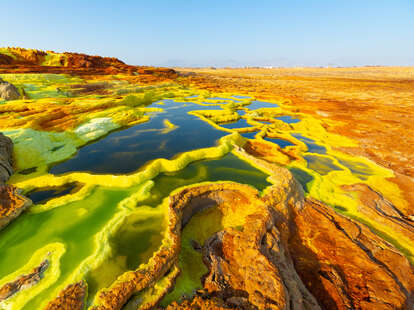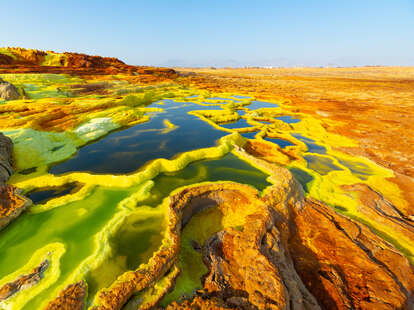

Let’s begin with this: yes, this place is really, truly on Earth.
It’s no secret that Mother Nature loves to get weird, and man, we love it when she does. But of all the freaky creations she’s dreamt up during her 4.5 billion years of existence—god-like mystery monoliths, swirling crimson deserts, oceans that glow—one of the strangest has to be Ethiopia’s Danakil Depression.
Even the likes of everybody’s favorite steaming rainbow lake—also known as Yellowstone’s famous Grand Prismatic Spring—pales in comparison to this staggering work of geological art. Out in the middle of a sweltering, arid expanse marked by spires of red rock, enormous technicolor pools ripple off one another. They almost resemble a fiery-hot, ultra-acidic version of Tuscany’s hot springs, their contents aquamarine and chartreuse, and their rims yellowed and stippled like popcorn yet hard as stone.


The springs are found in Dallol in the Afar region of northern Ethiopia, where apparently, record-setting is a piece of cake: With an average temperature of 95ºF, Dallol is the hottest inhabited location on the planet; in summer, temperatures regularly swell to a blistering 122ºF. It’s also one of the lowest points on Earth, dipping to more than 410 feet below sea level.
Such extreme conditions can’t help but breed utterly bizarre phenomena. Within the nearly 4,000-square-mile Danakil Depression are dozens of extraordinary natural wonders, including sweeping salt flats, colorful lakes, and active volcanoes.
Volcanic activity heats the spring water, causing certain minerals—sulfur, salt, copper—to rise to the surface, otherworldly shades of blue, green, and yellow blooming into existence as a result. As you may have guessed, you can look, but you can’t touch: This is sulfuric acid we’re dealing with here. In other words, if you dip your little pinky toe in, your skin is gonna melt like wax off a candle.


The springs are also filled with extremophiles—microbes who live in extreme environments, not dissimilar to those in the Grand Prismatic Spring. Since, against all odds, they’ve managed to survive in such inhospitable conditions, scientists began to wonder: Could life manage to thrive in conditions equally as or even more intense than this—say, for example, on Mars? Now, along with a canvas for Mother Nature, the area is often used by astrobiologists to conduct research about what alien life might look like on other planets.
Considering how wildly fucking intense the Danakil Depression is, you’d think they’d have it taped off for miles and miles around Area 51-style, allowing only professionals to explore its expanses. But no! From Addis Ababa, Ethiopia’s capital, or Mekele, the largest city near the depression, travelers can sign up to embark on guided tours, including multi-day options for as little as $250.
Once you’re out in the desert, you can take casual strolls past sulphuric geysers, take a dip in crystal-clear (non-acidic!) pools in the salt flats, glimpse the highly active Erta Ale volcano, and—of course—wander through Dallol’s acid fields. You may also spot the Afar people—the only group to live this far out—riding across the dry earth on camels, transporting salt collected from the deposits near their village, Hamed Ela, to nearby markets.
If you plan on making the trek, it’s best to visit between November and March, when the temperatures are at their most tolerable, by which we mean still around 95ºF. Pack sunscreen, and hey—try your best not to end up like that old lady at the end of Dante’s Peak, okay?







